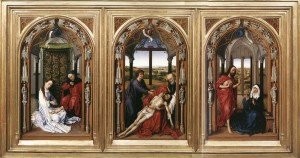Han Urs von Balthasar has said, “Christian preaching is the proclamation of the Risen Crucified One.”1 The preacher’s task then is to proclaim three things simultaneously. We must proclaim that our Lord Jesus Christ is the incarnate Son of God, that he was obedient unto death upon the cross, and that he was resurrected from the dead. The challenge for the preacher is to articulate the continuity that runs through Jesus Christ’s life, death, and resurrection. How might we proclaim the Risen Crucified One?
Jesus Christ perfectly embodies the whole of the gospel, but communicating this is difficult because we experience everything within time. We speak of past events, future hopes, and present experiences. In Romans chapter 5 Paul artfully weaves together past, future, and present tenses. The message that rings through it all is that Jesus Christ has justified us, will save us, and is reconciling us. We must not limit Christ’s work to any one tense; we must not limit Jesus’ work to his life, death, or resurrection. All must be held in unity to communicate the fullness of the gospel. Essentially, preaching must proclaim that Jesus Christ is the beginning and the end, the alpha and the omega. His person is perfectly one, but it is hard to perceive this as creatures bound in time.
Jesus Christ’s work extends beyond a particular time in history into the past, future, and present. Pay attention to the change of tense within each sentence Paul uses in Romans 5:8-11. I have highlighted past in italics, future in bold, and present is underlined.
God proves his love for us in that while we still were sinners Christ died for us. Much more surely then, now that we have been justified by his blood, will we be saved through him from the wrath of God. For if while we were enemies, we were reconciled to God through the death of his Son, much more surely, having been reconciled, will we be saved by his life. But more than that, we even boast in God through our Lord Jesus Christ, through whom we have now received reconciliation. (Romans 5:8-11 NRSV)
This passage reflects the ways in which God’s love permeates all time. It is not simply a past event, future hope, or present experience. As creatures bound in time we cannot fully comprehend the whole of Jesus Christ’s saving work at any one time. We tend to parcel out the tenses of the good news and in doing so we lose sight of the whole, of the important ways in which each tense supports and fulfills the other.
We have been, will be, and are reconciled through Jesus Christ. It is important to note reconciliation always takes place through Christ. We have been justified by his blood and reconciled to God through the death of his Son. We will be saved by his life. We are, now, being reconciled to God through our Lord Jesus Christ. The alpha and the omega is the whole of the gospel. Jesus Christ has been, will be, and is the good news we proclaim.
In the first lesson this week the people of Israel raise a question, “[i]s the Lord amoung us or not?”(Exodus 17:7) In our present situation this is a question we often ask. Where is God? It is hard to observe God’s presence in our lives when we focus on particularly difficult times. Suffering and pain present us with a palpable sense that something is wrong and we are confident this is not what God intends for us. The good news is that Christ bore our sin and suffering and reconciled us through his death. Death usually is the ultimate break in the continuity of life, but within Christ it is the precise locus that maintains a sense of continuity. Jesus Christ died for us while we were sinners and this is good news for Paul and us all. We can note this in Jesus’ interaction with the Samaritan woman at the well, she testifies, “[h]e told me everything I have ever done.” (John 4:39) Jesus knew all of her sin and shame, but this was good news for her. She was fully known and fully loved. Upon the cross Jesus knows us fully, all of our suffering and sin. Christ death is the fullest expression of his love for us, but it must not be separated from his life and resurrection. Jesus loved the woman at the well with his life, he knows our sin and suffering with his death, and he embodies our hope with his resurrection.
In what ways have you experienced God’s love in the past? What do you hope for in the future? How are you being reconciled to God currently? How are you going to proclaim the Risen Crucified One?
1 – Hans Urs von Balthasar, Mysterium Paschale: The Mystery of Easter, (San Francisco: Ignatius Press, 2005), 66.

